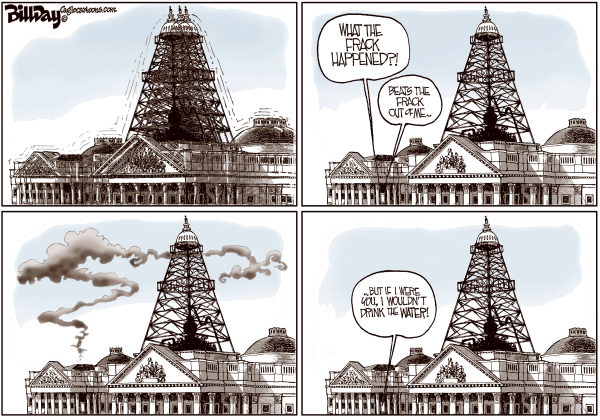Fracking the Central Coast
Monterey Shale a Prime Target

Santa Barbara has fought hard to protect its coastline from offshore drilling. Ever since the 1969 oil spill, Santa Barbara has been at the forefront of the environmental movement. But the oil and gas extraction process known as fracking is posing a new threat to our county. Oil companies have been expanding fracking operations up and down the coastline from downtown Los Angeles to Monterey, and Santa Barbara’s position on top of the Monterey Shale – a rock formation considered the largest single shale-oil play in the country – makes it a prime target for future fracking operations.
Fracking involves injecting massive amounts of water, sand, and toxic chemicals into the ground to fracture rock to extract oil and gas. Fracking has been happening silently in California for years but now our state is poised to see a huge increase in much more intensive fracking operations that target the Monterey Shale.

California doesn’t track where fracking happens, and many of the chemicals used in fracking are considered a “trade secret,” preventing researchers from knowing just how toxic fracking fluids are. However, independent studies show that of the 632 chemicals identified in fracking fluids, more than 75 percent can affect the skin, respiratory, and gastrointestinal systems. About 40 to 50 percent can harm the brain and nervous system. And 25 percent can cause cancer. There has been extensive discussion about disclosure regulations in California, but based on what we already know, fracking fluid is extremely toxic and shouldn’t be pumped into the ground under any circumstance.
The cement casings that line oil and gas wells degrade over time. Initially, about one out of every 20 wells might fail, meaning that they can leak the toxic chemicals into local groundwater. Over time, many more are likely to fail to keep hydrocarbon gases and other contaminants from seeping up into aquifers. And even if the wells don’t leak, fracking wastewater is often disposed of in leaky surface pits or by pumping it back into the ground into disposal wells, which have their own set of problems.
It’s not just California’s already scarce water resources that are at stake. Numerous studies show that the fracking process itself results in significant emissions of greenhouse gases – in addition to emissions from burning the gasoline and diesel derived from oil extracted by fracking. Expanding fracking in California flies in the face of the state’s efforts, under AB 32, to reduce greenhouse gas emissions.
Furthermore, fracking has the potential to significantly harm California’s vibrant agriculture industry. In Texas, some operators are using over 10 million gallons of water just to frack a single new well – such intense water use would only increase demand for California’s already limited supply of fresh water. There have been multiple instances across the country of contaminated water harming livestock and ruining agricultural land. A Kern County farmer received $8.5 million in damages after his entire almond orchard died from being watered with well water contaminated by a nearby oil and gas operation. Given this track record, it’s understandable that wineries in Santa Barbara are voicing their concern.
Santa Barbara has had a long and rocky history with the oil industry. Most famously, three million gallons of crude oil spilled into the channel in 1969, sparking an environmental movement that led to many of the environmental regulations we take for granted today. Now, oil companies have already begun buying up land and mineral rights along the Central Coast for future fracking operations.
Greka Oil & Gas Co., now known as HVI Cat Canyon Inc., was responsible for over 400 leaks and spills in Santa Barbara County between 1999 and 2008, spilling over 150,000 gallons of oil and violating over 1,700 county regulations in the course of several months. The push to intensify drilling and fracking in Monterey County would lead to many more accidents and spills. Santa Barbara County supervisors changed zoning code to require separate permits and public hearings for future fracking operations in our county, which provides an important layer of oversight on the industry, but action is needed at the state level.
Since Governor Brown has done little to address Californian’s concerns about fracking, we must turn to our legislators. Both State Senator Hannah-Beth Jackson and Assembly Member Das Williams are long-time supporters of environmental causes, and have led in the fight against offshore drilling. As they sit on their respective Natural Resources Committees, they need to take a stand and fight for a statewide moratorium on fracking.



